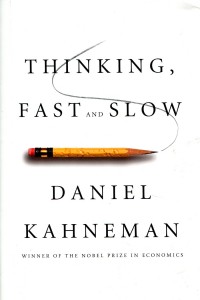Behavioral Economics and Insight Innovation
Behavioral Economics and Insight Innovation
 The rise of behavioral economics is more than a buzz trend. We have reached a tipping point in our industry for people accepting that humans do not behave according to the rational economic model and can’t or won’t always tell us the “why” behind their behavior. This bodes well for advanced market research techniques such as implicit research technology and biometrics. It also bodes well for the incorporation of BE into research design and strategic consulting engagements.
The rise of behavioral economics is more than a buzz trend. We have reached a tipping point in our industry for people accepting that humans do not behave according to the rational economic model and can’t or won’t always tell us the “why” behind their behavior. This bodes well for advanced market research techniques such as implicit research technology and biometrics. It also bodes well for the incorporation of BE into research design and strategic consulting engagements.
In our experience consulting and designing research around BE we have found that many insights divisions, brand and product managers, and marketing executives are attracted to BE because they see it as a significant source for novel inspiration. Once engaged, we find that these clients are pleasantly surprised to discover that they are currently using many BE effects in their current best marketing practices. This lends immediate credibility to the approach and stimulates additional interest. The benefit of knowing why a current marketing tactic works so well (e.g. BOGO’s works so well because of the irrational emotion response to FREE! from the certainty effect) is that this same fundamental principle can be reapplied in different ways to achieve similar results. For example, the certainty effect can be applied to evoke emotion without giving away product, by positioning brands or products as the choice that will provide certain satisfaction. So, not only does the audience find important justification for current practices, but they also find new ways of thinking about how to influence their target audiences more effectively.
Fortunately for market researchers, generating novel ideas on how to market more effectively leads to the need for testing which applications are going to be most effective. This is particularly promising for firms that design consumer choice studies because environmental cues can be manipulated experimentally, thereby providing cause and effect evidence for the efficacy of the proposed BE manipulation. We have written elsewhere that this offers significant promise for firms steeped in BE knowledge with special expertise in experimental design and choice studies. Given that there are hundreds of documented human irrationalities the promise of incorporating BE into your research practice may be profound.
 However, with that promise, also comes potential peril. As we began to see on display at IIeX, many firms are scrambling to incorporate BE without a strong understanding of the fundamentals. In fact, there is a dangerous notion that applying BE is easy. In fact, one prominent speaker even suggested that “if you want to begin to practice BE, just pick up one of the several new popular science books”. Another prominent speaker made the insightful observation that there is a lot of interest but not a lot of deep knowledge, by asking the audience who had bought Kahneman’s Thinking Fast and Slow (about half the audience raised their hands), and then asking how many had actually finished the book (1 or 2 people raised their hands). Thinking Fast and Slow is perceived as the current popular bible of BE. It is written for a broader audience, but it has greater density in detail than your typical popular science book.
However, with that promise, also comes potential peril. As we began to see on display at IIeX, many firms are scrambling to incorporate BE without a strong understanding of the fundamentals. In fact, there is a dangerous notion that applying BE is easy. In fact, one prominent speaker even suggested that “if you want to begin to practice BE, just pick up one of the several new popular science books”. Another prominent speaker made the insightful observation that there is a lot of interest but not a lot of deep knowledge, by asking the audience who had bought Kahneman’s Thinking Fast and Slow (about half the audience raised their hands), and then asking how many had actually finished the book (1 or 2 people raised their hands). Thinking Fast and Slow is perceived as the current popular bible of BE. It is written for a broader audience, but it has greater density in detail than your typical popular science book.
The peril here is that if MR firms begin to build BE practices around the knowledge gained from reading popular science books, and can’t even finish those that offer deeper insight, the application of BE in MR may have a short shelf-life. This level of knowledge is not going to be sufficient for building practices that survive because their ability make a long-lasting business impact for their clients. MR firms developing BE expertise need to get deep knowledge on the why’s behind these effects by referencing the original sources of the work in the behavioral science literature. This level of knowledge is critical for the successful application of these ideas because the original sources detail the guardrails around when and why these effects occur (the behavioral science lingo for that is “moderating” and “mediating” conditions). If BE consultancies don’t know the guardrails for when and why an effect will work, we will have a lot of unsuccessful market applications, which will ultimately give the practice of BE a bad name.
Back to the promise side of things, there is significant opportunity for research on research (RoR) in the BE space. One session at IIeX tried to tackle one of the more vexing issues facing the practical study of BE effects with our current research tools. The session attempted to show how BE irrationalities could be studied with the widely adopted choice based conjoint method of studying behavior. This session offered that BE effects can be studied using a constant conjoint model and varying environmental factors as between-participant experimental conditions. This is true, but unfortunately it’s not news. Researchers implement between-participant design to study environmental factors on choice everyday.
Nonetheless, there is a profound opportunity for MR within this line of RoR. Namely, we need to tackle the fundamental model behind choice-based-conjoint which is a linear rational trade-off model. The MR firms who can implement choice models which can account for BE irrationalities within the model will have developed a quantitative research tool that can be used to efficiently test the plethora of business applications coming out of BE consulting engagements. This model will need to incorporate quantitative measures of emotion along with rational trade-offs. Fortunately, the behavioral science literature has several models of that nature that could be put to practice in our industry if MR firms see the long-term benefit of getting deeper than popular science books allow.
